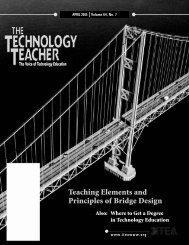K-12 Engineering Education Standards: - International Technology ...
K-12 Engineering Education Standards: - International Technology ...
K-12 Engineering Education Standards: - International Technology ...
Create successful ePaper yourself
Turn your PDF publications into a flip-book with our unique Google optimized e-Paper software.
Let students conduct research to determine if any<br />
meaningful studies have been done that propose alternative<br />
ways to avoid pedestrian challenges at street intersections.<br />
A number of small towns around the country have tried to<br />
minimize the impact of automobiles upon their residents<br />
and developed their land accordingly. What can be learned<br />
from this? One such town is located in the Radburg area of<br />
Fairlawn, NJ. This entire section of the town is completely<br />
different in appearance and design. Cars and homes are<br />
purposely kept separate, with lots of walking and open space<br />
between the clusters of homes. Radburn dates back to 1929.<br />
Is there an elevated walkway across a busy highway that citizens<br />
can now use?<br />
From a practical standpoint, could your town afford to have<br />
these elevated walkways at every corner? Is there enough<br />
space at each intersection? How would handicapped citizens<br />
gain access to them? What would it do to local traffic flow<br />
to have to rebuild all the street intersections? In a crowded<br />
downtown district, would it even be possible to make such<br />
major changes?<br />
How about underground passages beneath each intersection?<br />
Folks would just walk down a few stairs on one side and up<br />
a few stairs on the other side, and traffic would never bother<br />
them at all. Sure there are lots of underground facilities such<br />
as pipes and electric cables and communications lines, but<br />
couldn’t they be moved a little deeper to allow for folks to<br />
pass above them? This might be an interesting challenge<br />
for older cities with dense population centers. Would the<br />
underground route be less expensive or more expensive than<br />
the elevated walkway option?<br />
How about underground passages beneath each intersection?<br />
Planned community, Reston, VA, offers its residents plenty of<br />
alternatives to driving.<br />
Other U.S. planned communities such as Columbia, MD<br />
and Reston, VA may offer some insight into minimizing<br />
automobile-human being interactions. Another city that<br />
might be looked at is the Inner Harbor area of Baltimore,<br />
which has a network of elevated walkways for access to<br />
tourist, business, and hotel destinations.<br />
Other sources of information for understanding this<br />
problem may be garnered from:<br />
• Local town planning and engineering departments<br />
• Land use consultants and designers<br />
• Traffic and automotive experts and consultants<br />
• Architectural firms specializing in urban/town design<br />
• Roadway engineering firms<br />
• Highway planners<br />
19 • <strong>Technology</strong> and <strong>Engineering</strong> Teacher • February 2011
















